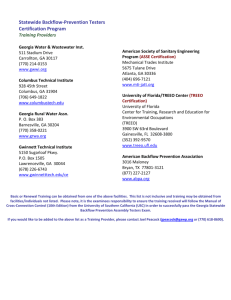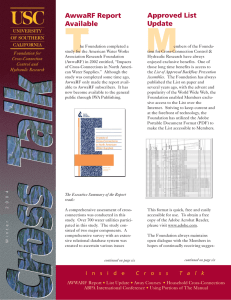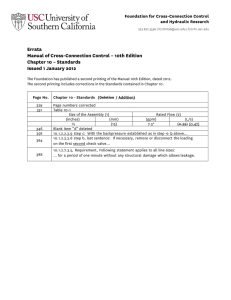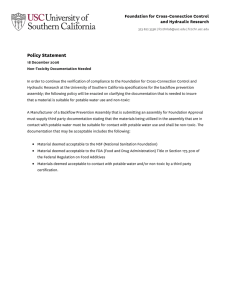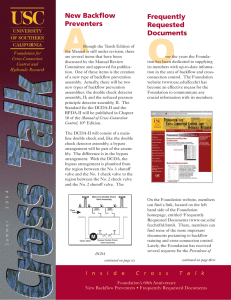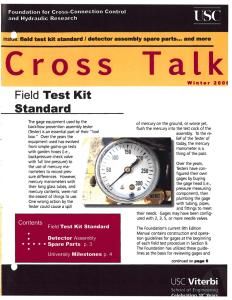Q T EPA Project on Certification vs
advertisement
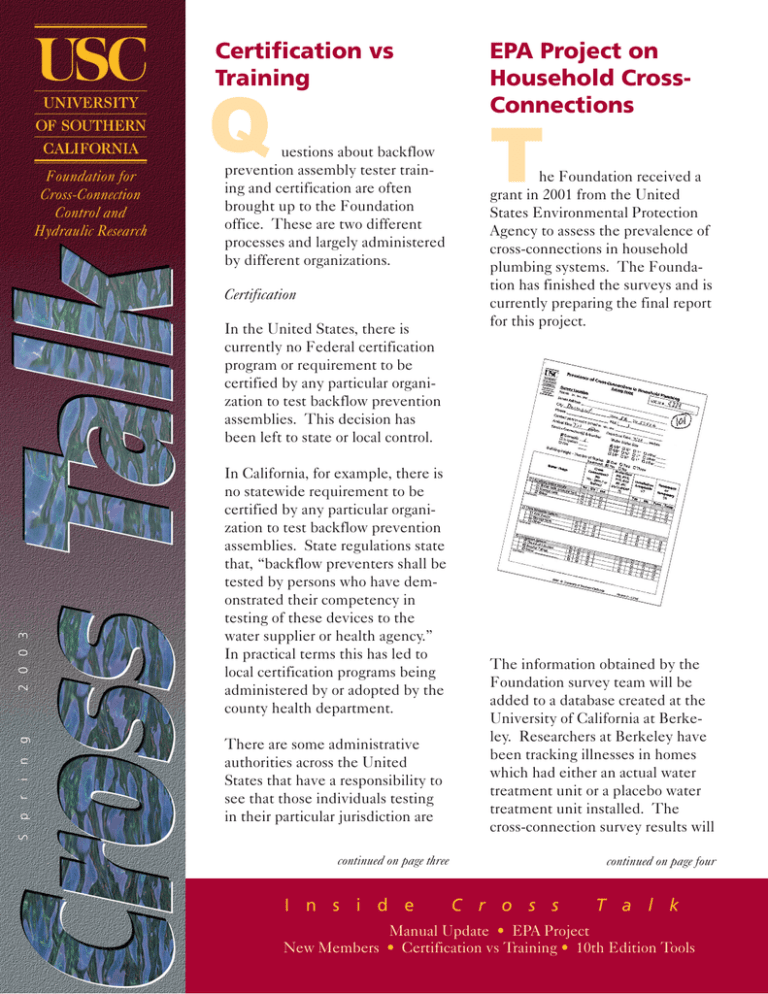
Certification vs Training Q uestions about backflow prevention assembly tester training and certification are often brought up to the Foundation office. These are two different processes and largely administered by different organizations. Certification In California, for example, there is no statewide requirement to be certified by any particular organization to test backflow prevention assemblies. State regulations state that, “backflow preventers shall be tested by persons who have demonstrated their competency in testing of these devices to the water supplier or health agency.” In practical terms this has led to local certification programs being administered by or adopted by the county health department. There are some administrative authorities across the United States that have a responsibility to see that those individuals testing in their particular jurisdiction are S p r i n g 2 0 0 3 In the United States, there is currently no Federal certification program or requirement to be certified by any particular organization to test backflow prevention assemblies. This decision has been left to state or local control. EPA Project on Household CrossConnections T he Foundation received a grant in 2001 from the United States Environmental Protection Agency to assess the prevalence of cross-connections in household plumbing systems. The Foundation has finished the surveys and is currently preparing the final report for this project. The information obtained by the Foundation survey team will be added to a database created at the University of California at Berkeley. Researchers at Berkeley have been tracking illnesses in homes which had either an actual water treatment unit or a placebo water treatment unit installed. The cross-connection survey results will continued on page three I n s i d e continued on page four C r o s s T a l k Manual Update • EPA Project New Members • Certification vs Training • 10th Edition Tools T Foundation Membership he Foundation’s Membership Program provides many benefits to the Members of the Foundation. These include: twenty percent discount on Foundation Training courses for any employee of the Member company/organization, the List of Approved Backflow Prevention Assemblies, printed quarterly, and access to the up-to-the-minute version of the List for those Members with Internet access. Members are encouraged to call the Foundation with technical questions. The Foundation’s Engineering Staff is available to assist Members with the various aspects of field testing backflow preventers, installing backflow preventers and administering their cross-connection control program. Advanced Irrigation Advanced Operator Short Schools Alta Loma Plumbing Contacting the Foundation Arbon, David Atascadero Mutual Water Company BPMS Backflow Consulting, Testing & Repair Bryan Water Services, City of C-H Educational Services Casper College Davis Plumbing Mailing Address: Foundation for CrossConnection Control and Hydraulic Research University of Southern California Kaprielian Hall 200 Los Angeles, CA 90089-2531 EMI Korea Co. Fetzer Vineyards Flour Hanford, Inc. Kent, City of O’Connor Sales, Inc. O’Hagan Corporation Phone: 866 545 6340 213 740 2032 Toll Free FAX: 213 740 8399 On-Site Testing Oracle Environmental Patterson, City of Pinel Plumbing Purdy McGuire e-mail: fccchr@usc.edu Web Site: www.usc.edu/fccchr Santa Cruz, City of The Clark Construction Group Vic’s Plumbing Co. Weston & Sampson Services Two Wyoming Association of Rural Water The Foundation accepts Purchase Orders via mail or fax and credit card orders (Visa, MasterCard, Discover) via telephone and the Web. Cross Talk is published by the Foundation for Cross-Connection Control and Hydraulic Research at the University of Southern California for Foundation Members. Limited additional copies are available to Members upon request. 2003 © University of Southern California. All rights reserved. Certification vs Training continued from page one indeed qualified, but do not wish to administer an entire program themselves. Many times these organizations will put forth a policy statement that will outline what it accepts as being sufficient qualifications to test backflow prevention assemblies. This may be in the form of accepting certification from a third party such as the American Backflow Prevention Association or the American Water Works Association. The administrative authority may require the tester to be tested directly by the administrative authority in the form of a written and/or performance examination. Whether administered by an administrative authority or a third party, most any certification program will require a certain amount of training which is acceptable to the certifying body. This training will meet certain minimum criteria of the certifying body. Another important aspect of a certification program is re-certification. Recertification, usually required every two or three years, ensures that the backflow prevention assembly tester maintains the skills and qualifications necessary to test backflow prevention assemblies. Re-certification is a process, which typically includes not only a fee payment, but also a written exam and a performance exam. Some certifying bodies may also require applicants attend a certain amount of training or education in the form of update seminars. continued on page six Manual Update T he Manual Review Committee for the Tenth Edition of the Manual of Cross-Connection Control is entering the final stages in the process leading towards the publication of the Tenth Edition. The final timeline has been set and publication of the Tenth Edition is due on 1 January 2004. The Manual Review Committee and the Foundation Staff still have much to do to get the Manual ready for publication, but the major decisions have been made and the details of wording are being worked out for several sections of the Manual at this time. Should any Member of the Foundation have any comments or recommendations for the Tenth Edition of the Manual, now would be the time to send comments to the Foundation Office. Comments can also be sent to the Manual Review Committee via the Web at: http://www.usc.edu/fccchr/mrc/ comments.html. Whether administered by an administrative authority or a third party, most any certification program will require a certain amount of training... A summary of each of the meetings may be found on the MRC website at: http://www.usc.edu/fccchr/mrc/, but one of the major changes is highlighted here. New Assemblies The MRC is working on and has agreed to publish specifications for the DCDA-II and the RPDA-II. These are double check detector assemblies and reduced pressure principle detector assemblies with continued on page seven Three EPA Project continued from page one be factored into the data to determine if illnesses may be attributed to cross-connections. The surveys indicated that 9.6% of the homes were found to have direct crossconnections to a health hazard. On-site surveys were conducted in 188 homes in the US Mid West. The data was analyzed to determine how many cross-connections existed in the homes. Additionally, it was determined if the crossconnections were direct or indirect and if the cross-connection constituted a health hazard or a nonhealth hazard. A survey form was created to make the data collection simple and consistent so that the USC Research Team analyzing the data would provide consistent and accurate results. The Field Operations Manager (FOM) for this project was a contractor who had been trained at one of the Foundation’s Course for the Training of Cross-Connection Control Program Specialists. The FOM was also involved in several discussions before the surveys took place to ensure that the data collected was transmitted to the USC Research Team in a manner that was understood with minimal ambiguity. The Foundation’s Quality Assur- ance Manager (QAM) for this project accompanied the FOM for the first several surveys to ensure consistency in data recording. Additionally, about half way through the project, the QAM again accompanied the FOM on several surveys to ensure quality control. As the Survey Forms were returned to the Foundation, three separate members of the USC Research Team independently analyzed the Survey Forms to determine how many water connections there were in each of several categories (e.g., kitchen, laundry, hose bibs, sewage system, irrigation systems, etc.) Those assessing the survey forms also determined how many of the water connections were protected and made a determination of the degree of hazard at the residence as well as determining whether the cross-connections constituted direct or indirect crossconnections. The surveys indicated that 9.6% of the homes were found to have direct cross-connections to a health hazard. On average, 73% of water use was unprotected, constituting cross-connections. Only 4.3% of the homes had either no unpro- Four continued on page seven Coming Soon: 10th Edition Tools W ith the arrival of the 10th Edition of the Manual of Cross-Connection Control, the Foundation is lining up several new tools and is improving on others to bring its members the information needed to succeed in the crossconnection industry. One of several new tools is the addition of an interactive CD-ROM that will be included in every copy of the 10th edition Manual. The CD-ROM will include ‘field forms,’ 3D animation and a searchable database of cross-connection incidents in past years. The ‘field forms’ section will include sample letters, installation guidelines and a model ordinance. All forms will be interactive and available in PDF (Adobe Acrobat) format. In addition to adding an interactive CD-ROM to the line of training tools, the Foundation is planning to release a new Field Testing Backflow Preventers Instructional Video. The instructional video will be available in DVD format and will include state-ofthe-art 3D animation. The DVD will include ‘chapter’ menus, allowing the viewer to skip between the different assemblies (DC, RP, PVB, SVB) instantly. The DVD format will allow the Foundation to add ‘Special Features’ to help testers more effectively. The Foundation will also be updating the Essentials of Cross-Connection Control presentation. Currently, the presentation is available in 35mm slides and CDROM, but beginning next year the presentation will only be available in PowerPoint format on a CD-ROM as an interactive presentation. The new presentation will include all new computer graphics and 3D animation. With several new and improved training tools, the Foundation will also update the Working Together for Safe Water informational brochure. Designed to introduce the basic concepts of backflow and cross-connection control to the public, the brochure The Foundation’s goal is to use today’s technology to bring the most relevant information in cross-connection control. continued on page six Five Certification vs Training continued from page three Training Training in and of itself does not constitute certification. Training is merely the means by which individuals gain the necessary knowledge and Six Six skills... Training is an important part of any cross-connection control program. It is also a necessary component of certification. Training in and of itself does not constitute certification. Training is merely the means by which individuals gain the necessary knowledge and skills to test and troubleshoot backflow prevention assemblies. Although training courses vary in their content, most training courses will consist of lectures covering various basics, such as hydraulics, how backflow occurs, responsibilities of the tester, the administrative authorities’ role and the actual field test procedures for testing backflow preventers. The Foundation’s courses spend the vast majority of the time on the actual field test procedures. The students are provided the opportunity to work with each of the backflow preventers covered: the double check valve assembly, the reduced pressure principle assembly, the pressure vacuum breaker assembly and the spill-resistant vacuum breaker assembly. Each student has an assembly in front of them the first time they learn the procedure so they can follow along with the instructor step by step and test the assembly themselves. There are plenty of assemblies and gages to allow the students ample opportunity to practice the field test procedures throughout the week. The Foundation’s courses are five-day courses allowing the student the opportunity to complete the necessary training during one workweek. There are many other courses offered in different regions in a five-day format similar to the Foundation. Other courses are offered over time, usually a semester at a community or trade college. Regardless of the duration of the course or the location, it is important that the student gets plenty of time to physically work with the assemblies and practice the correct field test procedures. Although quality training is a necessary part of a certification program, a certification program must accompany training in order to ensure that the testers continue to keep their skills current. As an overview, training teaches the testers the skills they need to test backflow prevention assemblies and certification demonstrates they have adequately acquired those skills and ensures they will retain them through recertification. Coming Soon: 10th Edition Tools continued from page five will include new graphics and upto-date information. The Foundation’s goal is to use today’s technology to bring the most relevant information in crossconnection control to those who need it most, allowing the everyday ‘tester’ or ‘specialist’ to be kept up-to-date and at the same time have its new training tools accessible to everyone. EPA Project continued from page four tected cross-connections or had unprotected cross-connections to a non-hazardous substance. Homes with a cross-connection (either direct or indirect) to a health hazard constituted 95.7% of the homes. Although this is a large percentage, the greatest concern was with the 9.6% of the homes having a direct cross-connection to a health hazard. In most cases, these cross-connections were due to improperly plumbed toilet fixtures, or specific toilet fixtures which could create a backpressure situation and force hazardous water from the toilet tank into the drinking water supply. 91% of the homes contained unprotected hose bibs, which are considered an indirect cross-connection to a health hazard. 61% of the homes contained unprotected crossconnections involving the toilets with 8.8% of these being direct cross-connections. Cross-Connections to tanks, vats or water softeners were found in 5.9% of the homes. Of these, 18.2% were direct cross-connections to health hazards. Unprotected cross-connections to health hazards within the heating/cooling system were discovered in 43.6% of the homes. Although there were a large number of cross-connections, many of these could be abated without much expense or effort. For example, most of the cross-connections would be protected if hose bib vacuum breakers were installed and properly listed fixtures were installed in the toilets. Still without these simple corrections, there remain a substantial number of cross-connections in these homes. Most of the residents were completely unaware of what crossconnections were or what could be done to prevent them. When the on-site survey was conducted, the residents were given a brochure describing typical household crossconnections and what could be done to abate them. It would appear that further study would be needed to get a better overall picture of household crossconnections. In this particular location there were no fire sprinkler systems, only a few irrigation systems and no pools or spas. Additionally, the average age of the homes was just under fifty years old. Even without further study, however, it is evident that better public education is necessary. Public education for the homeowner or resident would go a long way in helping to reduce the problem of cross-connections in the home. Although there were a large number of crossconnections, many of these could be abated Manual Update without much continued from page three a single check and meter included in a by-pass line around the second check. The level of backflow protection will remain the same as with the current DCDA and RPDA but the by-pass meter (along with a check valve) bypassing only the second check valve will allow for the assembly to have a lower overall pressure loss. expense or effort. Seven Training Courses Tester Course Los Angeles, CA 14-18 July 2003 Kauai, HI 18-22 August 2003 Los Angeles, CA 12-16 January 2004 Los Angeles, CA 17-21 May 2004 Specialist Course Upcoming Events AWWA- Annual Conference •Anaheim, CA 15-19 June 2003 Inland County Backflow Group- Seminar •San Bernardino, CA 10 Sept. 2003 ABPA- Western Region Backflow Conference •Las Vegas, NV 29 Sept.- 1 Oct. 2003 ABPA- Annual Conference •Long Beach, CA 9-12 May 2004 Los Angeles, CA July 28- Aug. 1 2003 Iowa City, IA 3-7 November 2003 Los Angeles, CA 26-30 January 2004 Foundation for Cross-Connection Control and Hydraulic Research School of Engineering University of Southern California Kaprielian Hall 200 Los Angeles, California 90089-2531 First Class US Postage PAID University of Southern California
